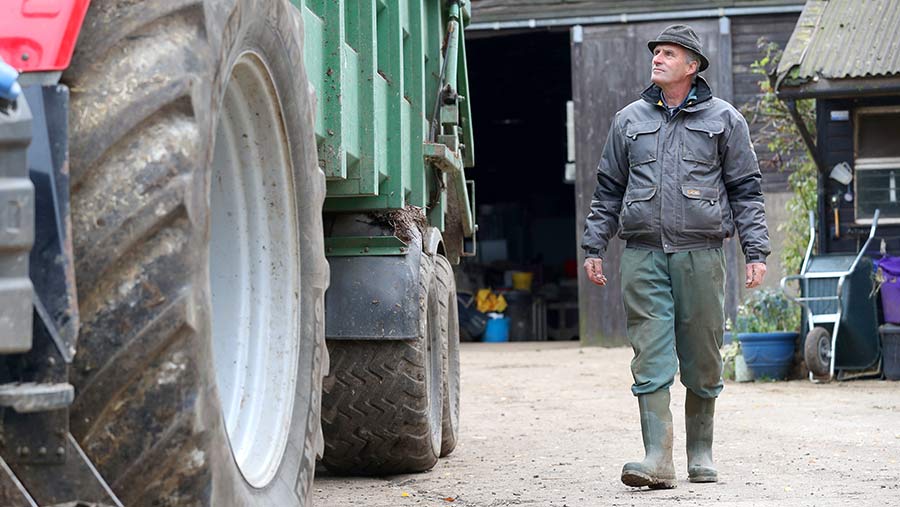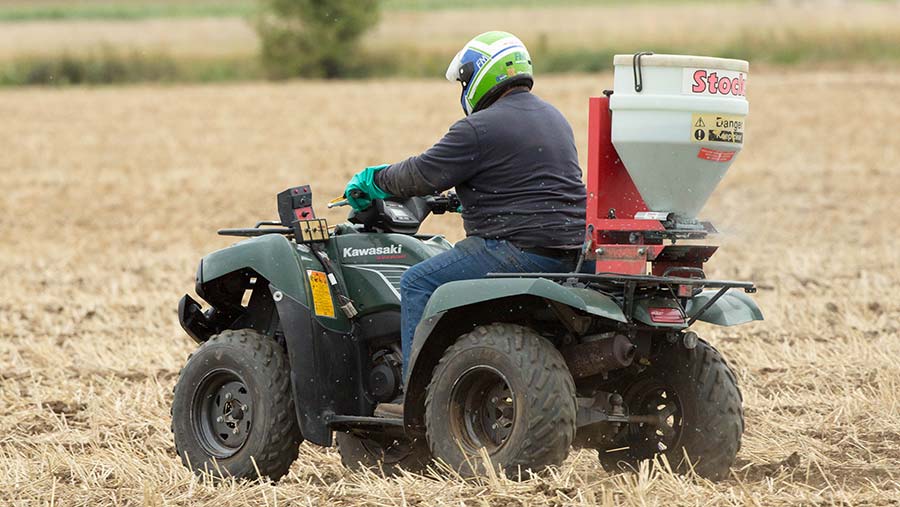Why farmers are backing campaign to cut farm accidents
 Will Dickinson © Adam Fradgley
Will Dickinson © Adam Fradgley A Hertfordshire grower who was lucky to escape serious injury in a farm accident has lent his support to a major agricultural safety campaign.
Will Dickinson, who farms at Cross Farm, Harpenden, told how he was almost crushed while changing the dual-wheel on a tractor. “I got caught under the wheel and damaged the nerves in my shoulder – my brachial plexus – and lost the use of my right arm.”
See also: Industry campaign urges farmers to #DriveSafetyForward
Mr Dickinson, who has since regained movement in his arm, said the hardest thing he had ever done was to repeatedly squeeze a rubber ball as part of his rehabilitation.
“Eventually the nerves came back and today I am fully functional,” he said.
The 58-year-old is now supporting a year-long safety campaign to reduce the number of fatalities and accidents in agriculture.
Organised by the Farm Safety Partnership, the initiative involves 38 organisations working to improve the industry’s safety record.
The campaign’s four areas
The campaign is focusing on four key areas of farm safety:
- Farm transport (winter)
- Working with livestock (spring)
- Child safety (summer)
- Preventing falls from height (autumn)
“Anything we can do to highlight the need for improvement can only help,” said Mr Dickinson. “The fatality rate has been the same throughout my career and machines are getting bigger and bigger. It’s important to operate them safely.
“You can’t physically see behind many machines now. When I started tractor driving, I had a little three-tonne trailer and a David Brown on the front. I could see 360º from the seat and behind the trailer. Today, machines are much bigger and there is no way you can see behind a 30ft-long 18-tonne trailer.”
About the campaign
Launched last month, the campaign kicked off at LAMMA. Farmers, contractors and farm workers are being urged to highlight the campaign by using the hashtag #DriveSafetyForward on social media – and to put a range of safety tips into practice.
Farm Safety Partnership members include Farmers Weekly, the Health and Safety Executive and the NFU.
Speaking about the campaign, NFU safety adviser Tom Price said: “The aim is to help farmers comply with the law – but more importantly to help them keep safe too.”
Agriculture has the poorest record of any industry in Britain, according to the Health and Safety Executive. Some 33 people were killed in agriculture across the country in 2017-18 – 18 times the all-industry fatal injury rate, according to the latest figures.
The partnership’s ultimate and ambitious aim is to reach a point where there are no farming fatalities. On the way to meeting this target, the campaign’s goal is to help halve the number of farm-related deaths by the end of the 2023-24.
Farm vehicle safety
Accidents involving moving vehicles account for a quarter of deaths each year in farming. In some years, this has risen to nearly a third of all fatalities.
The most common types of serious injury involve reversing manoeuvres, vehicles overturning and people using ATVs.
Key safety messages for transport
Follow Safe Stop procedure every time you leave the cab
- Put the handbrake on
- Put transmission in neutral
- Turn the engine off
- Take the key out of the ignition
Wear a seat belt
- Even on short journeys and around the yard
Drive legal and safe every time
- Make sure your vehicle is roadworthy before taking it out
- Check that brake lights work
- Make sure you can see out of mirrors and windows
- Check for drawbar ring wear and that trailers are hitched up securely
- Ensure loads are secure
Make your farm yard a safe yard
- Put in traffic routes
- Segregate vehicles and pedestrians
- Have adequate lighting, signage, speed limits and mirrors in yard
- Avoid reversing – set up one way systems
- Beware of overhead cables – make sure visitors know where they are
(Source: Farm Safety Partnership)
Safe stop procedure saves lives
Many accidents happen when people leave a vehicle without making sure it cannot move, the HSE says.
Even when the vehicle is stationary, you should make sure it is properly secured and made safe by following the Safe Stop procedure:
Handbrake on >> Transmission in neutral >> Engine off >> Key out
Although it may not always be convenient, remove the keys from a machine when it is not in use to prevent accidents from untrained and inexperienced people operating it.
It is your legal duty to ensure that vehicles, machines and handling equipment are inspected regularly and any faults repaired immediately.
All loads carried must be stable and secure. Many fatalities each year are caused by falling objects.
Materials handlers and loaders must have good cab protection as they are far more likely to be hit by any falling objects.
Tractors, trailers and other machinery must have brakes designed for the maximum loads and speeds at which they will operate.
New guide helps farmers comply with law
A new guide aims to help farmers know what they need to do to keep themselves and everyone else on farm safe and healthy.
Called What A Good Farm Looks Like, the guide covers everything from vehicles and machines to the safe use of pesticides.
The Health and Safety Executive says farmers who follow the guide are more likely to comply with the law – and avoid accidents and ill health.
HSE inspectors visiting farms this spring will look at the topics covered in the guide and check that the risks are being controlled, it adds.
To download the guide, visit the HSE website
Accident highlights need to use ATVs safely
A farmer ended up in court for failing to provide proper training after an employee was injured in an accident involving an All Terrain Vehicle (ATV).
Driven by a 23-year old farm employee, the ATV collided with a hedge in a field while being used to round up cattle.
No training or helmet had been provided – and the farmer had failed to comply with a previously issued improvement notice.

© Tim Scrivener
The investigation found that the employee had not been trained to use the ATV safely. She was not wearing a safety helmet, although one was available.
Other employees had operated the ATV without training and personal protection equipment provided was not used.
The farmer had received an improvement notice about three years earlier. He had initially complied with the notice but some staff had since left and he failed to train their replacements.
The farmer was fined £350 and ordered to pay £1,006 towards prosecution costs.
Farmers must appreciate the dangers associated with ATVs, the Health and Safety Executive said.
Use of personal protective equipment, especially head protection, was essential, as was following the manufacturer’s safety instructions – including operator age limits for different types of machine.
“The lessons to be learnt from this case are to ensure that people using such machines have been properly trained, that they are capable of remaining in control of the bike at all times, that any tasks undertaken are within their capacity, and that proper supervision is exercised,” the HSE said.
